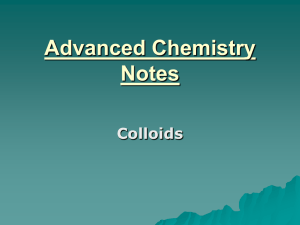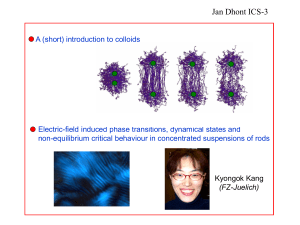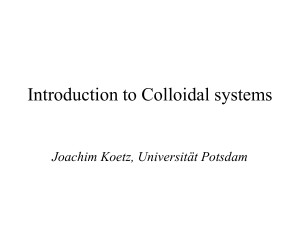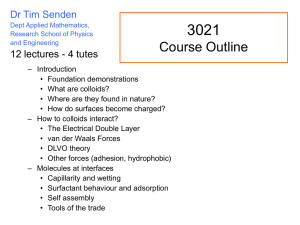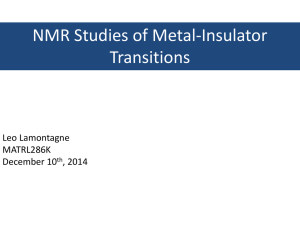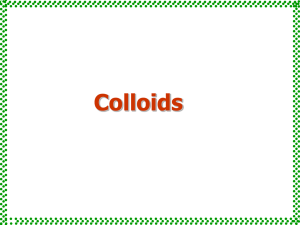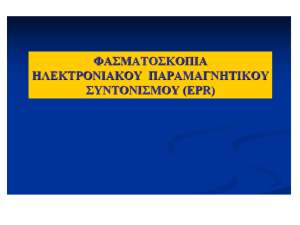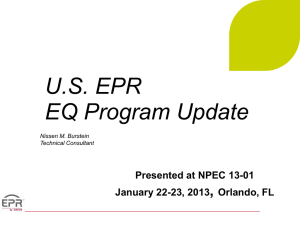VOLUME 76, NUMBER 24 PHY S I CAL REV I EW LETTERS
advertisement
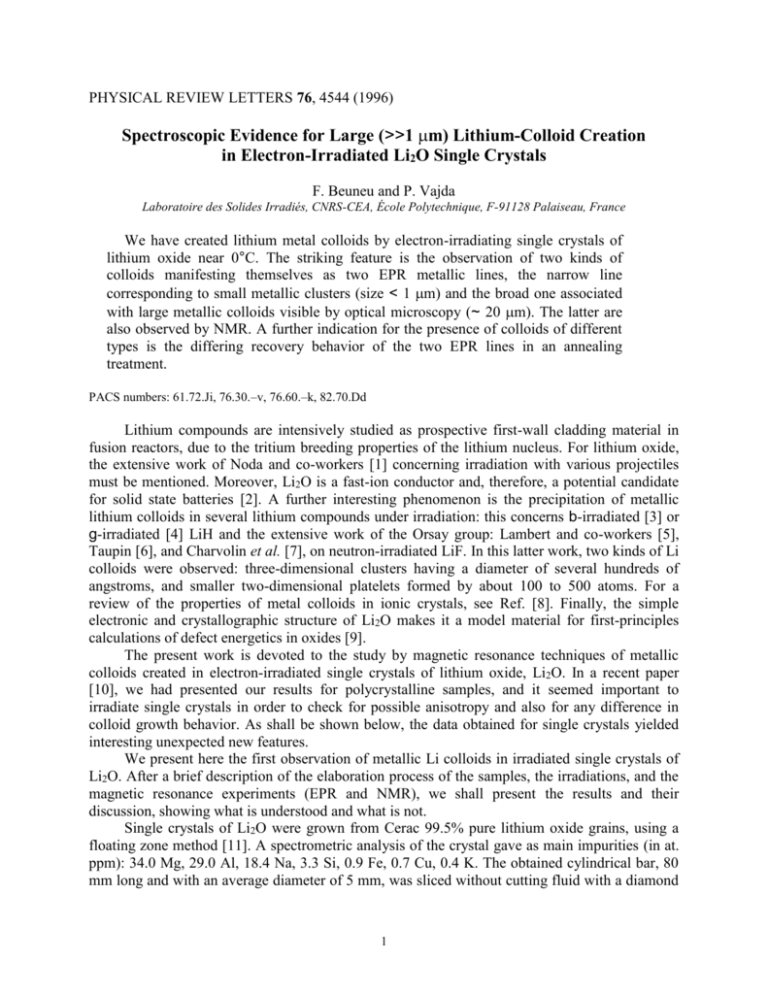
PHYSICAL REVIEW LETTERS 76, 4544 (1996) Spectroscopic Evidence for Large (>>1 m) Lithium-Colloid Creation in Electron-Irradiated Li2O Single Crystals F. Beuneu and P. Vajda Laboratoire des Solides Irradiés, CNRS-CEA, École Polytechnique, F-91128 Palaiseau, France We have created lithium metal colloids by electron-irradiating single crystals of lithium oxide near 0°C. The striking feature is the observation of two kinds of colloids manifesting themselves as two EPR metallic lines, the narrow line corresponding to small metallic clusters (size < 1 m) and the broad one associated with large metallic colloids visible by optical microscopy (~ 20 m). The latter are also observed by NMR. A further indication for the presence of colloids of different types is the differing recovery behavior of the two EPR lines in an annealing treatment. PACS numbers: 61.72.Ji, 76.30.–v, 76.60.–k, 82.70.Dd Lithium compounds are intensively studied as prospective first-wall cladding material in fusion reactors, due to the tritium breeding properties of the lithium nucleus. For lithium oxide, the extensive work of Noda and co-workers [1] concerning irradiation with various projectiles must be mentioned. Moreover, Li2O is a fast-ion conductor and, therefore, a potential candidate for solid state batteries [2]. A further interesting phenomenon is the precipitation of metallic lithium colloids in several lithium compounds under irradiation: this concerns b-irradiated [3] or g-irradiated [4] LiH and the extensive work of the Orsay group: Lambert and co-workers [5], Taupin [6], and Charvolin et al. [7], on neutron-irradiated LiF. In this latter work, two kinds of Li colloids were observed: three-dimensional clusters having a diameter of several hundreds of angstroms, and smaller two-dimensional platelets formed by about 100 to 500 atoms. For a review of the properties of metal colloids in ionic crystals, see Ref. [8]. Finally, the simple electronic and crystallographic structure of Li2O makes it a model material for first-principles calculations of defect energetics in oxides [9]. The present work is devoted to the study by magnetic resonance techniques of metallic colloids created in electron-irradiated single crystals of lithium oxide, Li2O. In a recent paper [10], we had presented our results for polycrystalline samples, and it seemed important to irradiate single crystals in order to check for possible anisotropy and also for any difference in colloid growth behavior. As shall be shown below, the data obtained for single crystals yielded interesting unexpected new features. We present here the first observation of metallic Li colloids in irradiated single crystals of Li2O. After a brief description of the elaboration process of the samples, the irradiations, and the magnetic resonance experiments (EPR and NMR), we shall present the results and their discussion, showing what is understood and what is not. Single crystals of Li2O were grown from Cerac 99.5% pure lithium oxide grains, using a floating zone method [11]. A spectrometric analysis of the crystal gave as main impurities (in at. ppm): 34.0 Mg, 29.0 Al, 18.4 Na, 3.3 Si, 0.9 Fe, 0.7 Cu, 0.4 K. The obtained cylindrical bar, 80 mm long and with an average diameter of 5 mm, was sliced without cutting fluid with a diamond 1 blade saw. As far as possible, the slices were kept under vacuum to prevent pollution by air moisture. The final samples, obtained by cleavage, were typically <1 mm thick transparent platelets, oriented parallel to (111). The electron irradiations were performed with the Van de Graaff accelerator of our laboratory. The samples were wrapped with a 10 m thick copper foil and suspended in hydrogen gas used as cooling fluid. The beam was perpendicular to a (111) plane. The electron energy was chosen to be 1 MeV ensuring uniform damage across the sample thickness, and the irradiation current controlled such as to maintain the sample temperature at 275 +- 5 K: a typical value was 40 A/cm2. We have shown previously [10], for polycrystalline samples, that an irradiation temperature above 200 K was needed to obtain metallic colloids. Four crystals were irradiated with different total fluences, respectively, 0.75, 6.05, 15.0, and 21.3 C/cm2. EPR experiments were done with a Bruker ER 200D X-band spectrometer operating at 9.5 GHz, in the 4–300 K temperature range. A TE104 double cavity was used, with a CuSO4 standard kept at room temperature, in order to get rid of the possible cavity Q-factor variation with temperature. NMR experiments were performed with a Bruker MSL 360 spectrometer at room temperature; the resonance of the 7Li nucleus (93% abundancy) near 140 MHz was used. Figure 1 gives the EPR signal detected in a sample irradiated with a fluence of 6.05 C/cm2 (3.8 1019 e/cm2). All the numerical data given hereafter correspond to this sample. The spectrum, taken at room temperature, clearly decomposes in two lines: a very narrow one (peak-to-peak width around 10-2 mT), Lorentzian in shape, whose saturation properties are compatible with a T1 ~ T2 behavior, and a broader line, not saturated with full microwave power (250 mW), FIG. 1. Room-temperature EPR spectrum of Li2O irradiated at 280 K with 1 MeV electrons. Fluence - 3.8 1019e/cm2. Microwave power = 0 dB (250 mW). Two colloid lines at g = 2.0023 are detected. Here, the narrow line is well saturated and overmodulated. whose shape looks like the “metallic” shape described by Feher and Kip after a model by Dyson [12]. Note that the signal presented in Fig. 1 is taken under conditions such that the narrow line is well saturated and overmodulated; when this is not the case, only the narrow line is visible, and can be easily analyzed as a good Lorentzian line. The two lines are centered at g = 2.0023. In our work on polycrystals [10], we observed one single symmetric and narrow line corresponding to the narrower line presented here; no broad line was detected. The temperature dependence of the line intensities (obtained by double integration of the signal) reveals interesting features; it is given in Fig. 2. The narrow line, when taken in conditions where it is not saturated, follows a Pauli T-independent law, while the broad one, integrated after a fit by a Dysonian line shape with AyB - 2.55 (ratio of the lobe amplitudes), shows a more unusual behavior: the intensity increases with temperature, in a more or less linear manner, so that its extrapolation to low temperatures seems to vanish near T - 50 K. The width of the narrow line decreases from 17 to 10 T 2 FIG. 2. Temperature variation of the two EPR line intensities (obtained by double integration). : broad line; : narrow line. when T varies from 4 to 300 K, while the broad linewidth decreases with increasing temperature, from 1.3 mT at 100 K to 0.6 mT at 300 K. This latter variation is shown in Fig. 3. Finally, no anisotropy of the properties of these two lines appeared when the sample was rotated in the static magnetic field. For the same sample, we give in Fig. 4 the NMR 7Li signal at room temperature. Two lines are seen: a broad one near 0 ppm (taken with a pulse repetition time of 60 s and a 10 times accumulation) and a narrower one near 250 ppm (pulse repetition time of 1 s and a 1000 times accumulation). For each line, the phase was chosen in such a way that the line is as symmetric as possible. The phase shift between the two signals can be due to several reasons: the width of radio-frequency irradiation was of the same order as the frequency shift between the two lines (35 kHz); also, we cannot exclude quadrupolar effects. We prefer to conclude here that this phase shift is not physically meaningful. Four samples were irradiated, partly for reproducibility reasons, partly to check for a possible dose dependence, which will be discussed in a full article. The signals presented in this Letter were always observed, except for the crystal with the lowest fluence, which shows only the narrow EPR signal. FIG. 4. Room-temperature 7Li NMR spectrum of the sample of Fig. 1. Left line: pulse repetition time of 1 s; accumulation 1000 times; center line: pulse repetition time of 60 s; accumulation 10 times. The phase is adjusted for each line. FIG. 3. Temperature variation of the width of the broad EPR line. These results clearly establish the existence of metallic precipitates in our irradiated samples. The very narrow EPR line, with its free-electron g value and even more its Pauli-like T dependence, stems from metallic lithium. The Lorentzian line shape proves that these Li colloids are quite small, with a radius lower than the skin depth at 9 GHz, which is around 1 m for a typical metal. The spin density is estimated by integrating the line and by correcting the result by the ratio TF/T, where TF, the Fermi temperature of metallic Li, is taken as 55 000 K. With such a correction, we get a spin concentration of 1.05 x 1024. The broader EPR line seems more 3 surprising; its g value and its T dependence strongly suggest that it corresponds also to metallic lithium. The line shape can be fitted quite satisfactorily in the whole temperature range by a Dysonian form with the wellknown value of A/B = 2.55 [12]. Such asymmetric shapes are obtained when the metal thickness, here the colloid radius r, is larger than the microwave skin depth . It is deduced here that this second kind of colloid is quite sizable, much larger than 1 m. Some size distribution of our colloids is very likely to occur. However, the good quality of the Dysonian fit of the broad line shows that the consequence of such a distribution on the relaxation times is probably not large. Preliminary electron-microscope observations on deposited powder obtained from crushed irradiated polycrystalline Li2O pellets showed Li colloids of 10– 30 nm size. The single crystals exhibited two types of colloids: small ones, analogous to the former, visible in electron microscopy and probably also created by the very intense irradiation by the microscope electron beam, and much bigger ones, of ~20 m in diameter, visible in an optical microscope. We shall expand on this subject in the full paper but this now explains why the Dysonian signal does not appear in a sample with micron-size grains. We can also remark that our optical microscopy observations confirm that the size distribution of the large colloids is quite narrow; moreover, for the next discussion, we need only a rough order of magnitude for T2. On the other hand, the lack of any anisotropy of the EPR signal is consistent with the metallic nature of the colloids. The key parameter of Dyson’s theory [12] is the ratio R = /e = (TD/T2)1/2, where TD is the electronic diffusion time through , T2 is the spin relaxation time, and e is the spin free path, given by e = (2DT2)1/2. D, the spin diffusion constant, can be written as D = vF2/3; the relaxation time is extracted here from resistivity data at room temperature. Taking Li = 10 cm and vF = 1.3 x 108 cm/s, we get = 8 x 10-15 s and D = 4.5 x 10-3 m2/s. From the EPR linewidth we obtain T2 = 1.2 x 10-8 s, which gives e ~ 10 m, a quite large value at room temperature. With the same value for , we get a skin depth ~ 1.6 m. We are faced with a paradox: if e is larger than both and r, the colloid radius, Dyson’s model must be extended to the conditions treated by Pifer and Magno [13] in the case of lithium films. These authors give, in the e > regime, the theoretical variation of A/B versus the d/ ratio, d being the Li film thickness. This is not very satisfactory for our data, because Pifer and Magno show that AyB cannot be 2.55 in this regime except for the accidental value of the ratio r/ = 1.7; in this case, A/B would be temperature dependent through , which is clearly not the case. We rather prefer to think that we are indeed in the more classical A/B = 2.55 Dysonian regime, for which e < and e < r. This implies much smaller values of e, meaning much greater values for the colloidal metal resistivity compared to that of bulk lithium. Note that, in [13], the variation of the lithium film resistivity with temperature is very near to that of the bulk resistivity, for film thicknesses in the m range. We deduce from these considerations that the structure of our large Li colloids is possibly not the same as that of bulk metallic Li: this point requires a more complete investigation, such as electron microscopy which is in progress. We wish to discuss now the unusual temperature dependence of the line intensity for the broad line. It has to be related to the fact that the skin depth decreases when T decreases, so that a thinner part of each colloid is observed. In the classical treatment of Dyson’s line shape, it is easy to show that the signal intensity is proportional to , thus to the square root of the metallic resistivity. Our strongly varying intensity implies that the resistivity must remain highly T dependent, in a manner comparable to bulk lithium. On the other hand, the temperature variation 4 of the linewidth can be interpreted through two considerations: (i) there is no phonon contribution (increasing with temperature) to the spin-flip rate, because lithium is a metal with virtually no spin-orbit interaction [14]; (ii) if there exists, for reasons still to be elucidated, a spin-flip probability at the surface of the colloid, there must be a term in the linewidth varying like the inverse of d, as only a skin of this depth is scanned by the EPR microwave field. In these conditions, it is very likely that an integration of the EPR line underestimates the spin concentration corresponding to this asymmetric line. However, such an integration gives a spin concentration of 2.48 x 10-3, with the same TF correction as above. It is important to note, in this context, that the two lines corresponding to colloids of different types recover at different temperatures in a thermal annealing treatment: the narrow line disappears at Tann = 300°C while the broad line remains up to 450–500°C. This is a further indication of the different nature of these two types of colloids. The otherwise complex recovery behavior shall be treated in an extensive paper. The NMR signal clearly shows the existence of metallic regions. The main line is related to the unaffected Li+ ions, while the position of the smaller line corresponds exactly to the published value for the Knight shift in metallic lithium [15]. By comparing the integrated intensities of the two lines (for each line the integral is taken with a phase such that the line is symmetric), we get a concentration of metallic Li of 3.0 x 10-3. This concentration is not very far from that obtained above from the broad EPR line; its value should be larger, because of the better radio-frequency penetration in the case of the NMR experiment (140 MHz versus 9.5 GHz). Considering the uncertainty of the TF correction applied, together with that due to the NMR phase shift, we can only conclude here that these two numbers have the same order of magnitude. We obtain two clearly different types of metallic lithium colloids in our irradiated samples. This must be compared to the results on neutron-irradiated LiF [6,7] mentioned in the introduction; the authors also observed two different kinds of metallic colloids. However, we believe that our two types are not the same as theirs. Their platelets resulted in a Curie law, which is consistent with a very small size, while our colloids give both an unambiguous metallic Paulilike behavior. Taupin [6] got no Dysonian shape on her EPR lines, indicating that the colloids were always smaller than 1 m. Concerning the NMR signal [6,7], they got an unshifted narrow line which we do not observe. In other words, our Li precipitates are bigger in size and more complicated in magnetic resonance behavior than theirs. We have shown that one can create a significant concentration of lithium metal colloids by electron-irradiating lithium oxide near room temperature. Except for very small fluences, where only a single narrow EPR line is detected, two EPR metallic lines are observed, corresponding to two kinds of colloids. The colloids related to the broader line are also observed by NMR; optical microscopy gives a typical size of 20 m for them. Their properties as measured with these two resonance techniques seem to indicate a very unusual behavior whose origin has to be clarified. The question of the correlation between electron fluence (accumulated dose) and the number of spins detected will be addressed in another paper. We believe that there is a high sensitivity of the colloid nucleation to experimental conditions, mainly to the initial impurity and defect contents of each sample: these play very probably an important role in the trapping of oxygen atoms, necessary to get colloid growth. We wish to thank G. Geoffroy for the x-ray observations, G. Jaskierowicz for the microscopy experiments, and F. Devreux (Laboratoire PMC, École Polytechnique) for the NMR experiment. The Li2O crystals were prepared by M. Lafleurielle and A. Revcolevschi of the Laboratoire de Chimie des Solides (Université Paris-Sud, Orsay) who are gratefully 5 acknowledged. This work was supported in part by the European Fusion Technology Program, Task UT-M-CM1. References [1] K. Noda, K. Uchida, T. Tanifuji, and S. Nasu, Phys. Rev. B 24, 3736 (1981); K. Noda, Y. Ishii, H. Matsui, and H. Watanabe, Radiat. Eff. 97, 297 (1986); for a more complete list, see Ref. 10. [2] K. Noda, Y. Ishii, H. Ohno, H. Watanabe, and H. Matsui, Adv. Ceram. 25, 155 (1989). [3] F. E. Pretzel, D. T. Vier, E. G. Szklarz, and W. B. Lewis, Los Alamos Scientific Laboratory Report No. LA-2463, 1961. [4] A. Berthault, S. Bedere, and J. Matricon, J. Phys. Chem. Solids 38, 913 (1977). [5] M. Lambert and A. Guinier, C. R. Acad. Sci. Paris 246, 1678 (1958); M. Lambert, Ch. Mazières, and A. Guinier, J. Phys. Chem. Solids 18, 129 (1961). [6] C. Taupin, J. Phys. Chem. Solids 28, 41 (1967); C. Taupin, Thèse d’État, Paris, 1968. [7] J. Charvolin, C. Froidevaux, C. Taupin, and J. M. Winter, Solid State Commun. 4, 357 (1966); J. Charvolin, J. P. Cohen-Addad, and C. Froidevaux, Solid State Commun. 5, 357 (1967). [8] A. E. Hughes and S. C. Jain, Adv. Phys. 28, 717 (1979). [9] A. De Vita, M. J. Gillan, J. S. Lin, M. C. Payne, I. Stich, and L. J. Clarke, Phys. Rev. Lett. 68, 3319 (1992). [10] P. Vajda and F. Beuneu, Phys. Rev. B 53, 5335 (1996). [11] J. Shindo, S. Kimura, K. Noda, T. Kurasawa, and S. Nasu, J. Nucl. Mater. 79, 418 (1979). [12] G. Feher and F. Kip, Phys. Rev. 98, 337 (1955); F. J. Dyson, Phys. Rev. 98, 349 (1955). [13] J. H. Pifer and R. Magno, Phys. Rev. B 3, 663 (1971). [14] F. Beuneu and P. Monod, Phys. Rev. B 18, 2422 (1978); P. Monod and F. Beuneu, Phys. Rev. B 19, 911 (1979). [15] G. C. Carter, L. H. Bennett, and D. J. Kahan, Metallic Shifts in NMR (Pergamon Press, New York, 1977). 6
